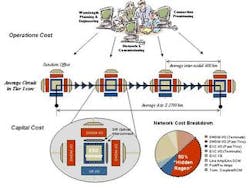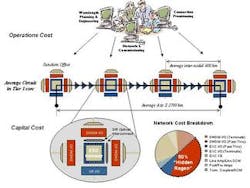Automating the core with an agile photonic network control plane
By Robert Nadon
Innovance Networks
This article will outline the key attributes of an agile photonic network control plane required to enable on-demand, lowest cost, end-to-end wavelength provisioning.
With a conventional DWDM system, turning up a single end-to-end wavelength across a network can take months due to the complexity of the wavelength engineering process and the need to deploy and configure equipment at all junction sites. This time and effort is an impediment to service velocity and a tax on operations (see Figure 1).
In North-American backbone networks, upwards of 70 percent of the electronics at junction sites is devoted to managing pass-through traffic.1 A networking solution that eliminates these "hidden regens" will not only significantly reduce this operations tax but also be far less expensive to deploy. Ultra-long-reach (ULR) technology addresses part of this cost-saving opportunity by extending the distance required between electrical regenerators by thousands of kilometers on point-to-point links.
However, backbone networks have intermediate points that must support traffic routing and termination within the maximum reach endpoints of a ULR system. Since only a portion of the traffic demand terminates at any given site, optical add/drop multiplexers (OADMs) are used to allow most channels to benefit from optical bypass, while enabling access at intermediate sites. Point-to-point ULR systems and OADMs allow specific routes within the transport network to benefit from reduced capital by enabling all-optical bypass. To extend these benefits beyond specific routes, ULR systems require additional flexibility to allow routing of wavelengths from any source in the network to any destination over a mesh connected DWDM layer. The recent emergence of tunable sources and filters and transparent photonic switching hardware make such an agile photonic network feasible.
Photonic switching, ULR technology, and tunability--when combined with control-plane based network intelligence--enable an agile photonic network that allows for the provisioning of end-to-end network wavelengths with the simplicity and speed of provisioning end-to-end sub-lambda (STS) circuits. The optical networking industry has lately been focused on the extension of Internet protocols to form the basis for optical layer control planes at sub-lambda, lambda, and fiber granularities. The control plane for an agile photonic network builds upon this groundwork to support the objective of significantly reducing the capital and operational expenditures associated with the DWDM layer. The distributed control plane infrastructure required for the agile photonic layer must also support the following new key functions:
Real-time engineering of end-to-end wavelength connections
Although ULR technologies greatly reduce the need for regeneration, some particularly long demands and those routed over a sub-optimal fiber plant (e.g. high PMD) will require regeneration at some point along the connection. The agile photonic network control plane must be able to determine where all-optical bypass of junction nodes is possible and where regeneration is required in order to ensure that target optical performance is achieved for connections of any length beginning at any source and terminating at any destination in a mesh connected photonic network. In order to make this determination, route-engineering algorithms must have access to accurate and up-to-date photonic attributes of the system. The control plane must automatically detect this information, distribute it to wherever the computations take place, and refresh it whenever conditions in the network change.
Routing and wavelength assignment
The agile photonic network must support the ability to route for lowest cost, and in particular, to minimize the number of OEO transitions in the network. The agile photonic network routing algorithm must take real-time resource availability and photonic performance into account when determining the optimal route for a given demand. The routing algorithm must also assign wavelengths to connections so as to avoid blocking and minimizing the need for wavelength conversion. Tunable sources and filters underpin the control plane's ability to dynamically assign wavelengths during connection setup.
Automated set-up and reconfiguration
Point-to-point DWDM systems are engineered to ensure that all wavelengths carried by the system achieve a target optical performance over a fixed distance. "Lighting" the capacity on point-to-point systems involves the installation and configuration of equipment for each wavelength. In contrast, the agile photonic network must support wavelength connections that follow any variety of routes that are of varying lengths and that can be re-configured at any point in time. The control plane must coordinate the actions of tunable sources, filters, switches, and amplifiers to ensure that wavelength traffic can be added and dropped at any point in the network without affecting existing connections. Additionally, the control plane must configure regeneration for the connection at the locations specified by the routing and engineering algorithms (see Figure 2).
The necessary components of an agile photonic network control plane are:
• Auto-discovery and distribution of photonic attributes, topology, and resource usage
• Routing, engineering, and wavelength assignment algorithms
• Signaling protocol for both internal and external connection signaling
• The ability to assign wavelengths and regeneration to a wavelength connection dynamically at the time of setup
• Dynamic line and switch control system capable of adding and removing mesh-routed end-to-end wavelength connections from the network without impacting existing traffic
By eliminating the labor-intensive and slow process of handcrafting individual wavelengths and replacing it with point-and-click provisioning of end-to-end wavelength circuits, the agile photonic network control plane provides carriers with the ability to quickly and cost-effectively scale network bandwidth.
The introduction of distributed control plane intelligence to an agile photonic network also opens the door for a number of new applications, previously impossible at the DWDM layer. Initially, these applications will leverage the ability to switch and reroute wavelengths to enhance the usability and maintainability of the DWDM network. These will pay immediate dividends to carriers in the form of shorter, more predictable downtimes and higher availability for wavelength circuits. In the future, these building blocks offer the potential to enable new wavelength service offerings through the use of advanced restoration options and bandwidth-on-demand applications through integration with external control planes.
Agile photonic networking will deliver on the value of the earliest of these applications in a single-technology, intra-carrier environment. As agile photonic networks become more widely deployed, carriers will benefit from control plane standardization efforts that focus on ensuring interoperability between agile photonic sub-networks within a single service-provider domain. To this end, the intra-carrier NNI being defined by the Optical Internetworking Forum2 (OIF) and the International Telecommunications Union3 (ITU) is an early priority for agile photonic networking. Inter-layer and inter-carrier signaling interfaces represent an evolution of this interoperability in support of future value-added applications.
References:
1 J. Frodsham, A. Solheim, "Next Generation Backbone Metrics," NFOEC 2001, Baltimore 2001
2 OIF oif2002.229 NNI Requirements--work in progress, April 2002
3 ITU-T Recommendation (pre-published) G.8080/Y.1304 Architecture for the Automatically Switched Optical Network (ASON), November 2001
Robert Nadon is product manager, network operating systems at Innovance Networks (Ottawa, Ontario). He can be reached at [email protected].


